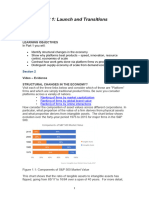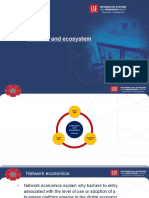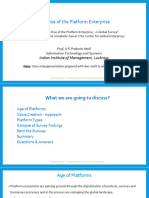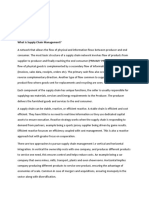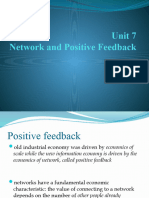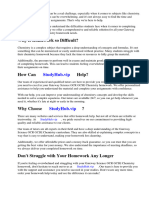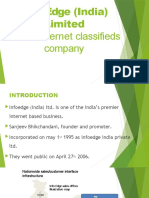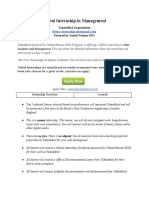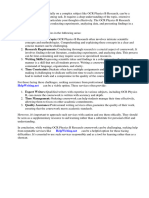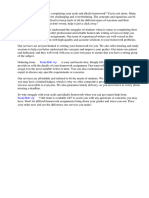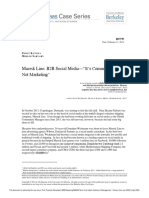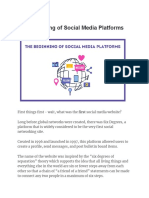Digital Transformation: Platform Strategies for Success – Video
Transcripts
Week 2 - Digital Transformation Concepts: Markets, Environment, and Structure
Video 1 - Foundations: Concepts, Market Environment and Structure
Welcome to Module 2 of Platform Strategy. So the goal today is to dig in a little bit deeper, and to
build some definitions and some conceptual foundations so that we have some tools to better
understand why we think the world has changed so much.
So, I'll be going through new economy concepts, multihoming and switching costs, and then one of
the fundamental drivers of platform strategies and pricing, two-sided networks. So, as you saw in the
previous module, network effects are one of the strong reasons why platforms grow so quickly.
m
er as
Systems that have more value, as more people join them, tend to have strong feedback that drives
co
growth. So now what I want to do is dig a little bit deeper into what it is that we mean when we say
eH w
the word, platform. And it's important, because the word has lost meaning, or loses meaning, if you
don’t narrow it down to the context that we're interested in’s when we say the word, platform, in this
o.
course, we mean a set of business and technology building blocks that service the foundation to build
additional products and services.
rs e
ou urc
We mean a set of resources that are used in common across a product family that also are subject to
network effects, such that the more people who adopt the system, the more valuable it becomes to
o
each user. We mean an open standard that allows for third parties to attach to it and gain access to
aC s
those resources; however, in order to do so, there then needs to be some kind of contractual
vi y re
framework and governance system in place to assure good behavior.
And, finally, we mean a business ecosystem that matches buyers with suppliers and ensures thick
enough markets that you have valuable transactions and allows those buyers and suppliers to use the
ed d
platform resources, and do business with one another. These definitions distill the work of a number
ar stu
of the world's premier authors, scholars, and business people in this area.
They all involve multiple users and partners and parties, they all involve network effect, and,
importantly, as we'll see in the design module, most of them allow for the reconfiguration of individual
is
parts, which then facilitates innovation.
Th
These definitions are all a little bit different, and, to our mind, no single word better describes these
systems than platform. So the reason to build some foundational concepts, and to build our toolkit to
help analyze these systems is that the businesses can be very complicated. And because of strong
sh
network effects, businesses tend to grow very quickly, which then means you get one chance to get
the right pricing, and the right launch system, and choice.
And the network effects often means that the winners take most or all of the market. And this is, of
course, the outcomes that we've observed in the previous generation of Windows and Adobe PDF, in
the current generation of iPods and the iOS and Android. We’ve seen this in Federal Express, in UPS
dominating the shipping industry, and LinkedIn and Facebook dominating the social.
Digital Transformation: Platform Strategies for Success Page 1 of 8
This study source was downloaded by 100000753566305 from CourseHero.com on 05-17-2021 06:12:55 GMT -05:00
https://www.coursehero.com/file/41813109/MIT-DTPSS-Module-2-Transcriptspdf/
� What we don't tend to think about as much are the businesses you haven't heard of lately. Things like
Sony's Betamax, things like IBM's OS/2,things like Amazon Auctions, eBay in Japan, Music Net, Engage,
and, more recently, Blackberry, are all examples of businesses that had every advantage in the world,
and yet do not dominate their respective industries today.
So, to set the context, think about the VHS versus beta story. So, we all know how this went. JVC had
VHS, Sony had beta, and they were going head-to-head for a number of years, and then, at some
critical point, the market tipped and beta went down and VHS zoomed up. That’s the example of an
outcome where you can have very strong feedback and then, quickly, the market can turn against you
and then, all of a sudden, you’re no longer in the battle.
That story, from the 70's and 80's, actually resonates all the way back to color television, and it's worth
thinking about the strategies and the players. So if you look at the1951 to 1959 period RCA was in a
standards battle against CBS to figure out, well, who was going to supply color televisions? And who
was going to establish the correct standard, or the standard that would get adopted? Now, CBS had
some powerful advantages in this battle, because they had lined up the Federal Communications
m
Commission as the preferred standard.
er as
co
However, CBS did not win this battle, and, in the period from 1951 to 1959, RCA didn’t win it either,
eH w
despite spending130 million dollars. We’ll come back to the outcome of this battle after we go through
some of the foundations to explain what drove the outcome.
o.
rs e
ou urc
Video 2 & 3 - Demand vs. Supply Side Economies of Scale
So, a network externality is a demand economy of scale, and as we saw in the examples earlier,
o
phones, fax, instant messaging, email network standards are all subject to the property that the more
aC s
people that use the system, the more valuable it becomes for each individual user. Demand-side
vi y re
economies of scale influence existing and prospective users ‘willingness to pay to join a particular
platform.
Supply-side economies of scale are realized when firms make large, one-time investments that they
ed d
can then leverage across multiple users, and then that reduces average costs. What’s very interesting
ar stu
in this industry is that many of the businesses that enjoy strong network effects also enjoy strong
supply-side economies.
However, conceptually they’re different, because on the supply side, the more you can take a single,
is
fixed cost and spread it across multiple users, then the lower the average cost becomes. On the other
hand, on the demand-side economy of scale, the more people who use the system, the more valuable
Th
it becomes to the individual user.
In a standard supply and demand system, you have rising average costs, and what that implies, then,
sh
is you get some crossover point where demand meets supply and you set a price. So, these are what
we call normal goods, things like soda, eggs, bread, oil production.
They all have, as you go for that marginal unit of supply, the marginal unit becomes incrementally
more expensive. On the other hand, when you have industries that are characterized by massive fixed
costs and very low variable costs, then you get a slightly different dynamic where the more users you
have for the system, the lower the costs become.
Digital Transformation: Platform Strategies for Success Page 2 of 8
This study source was downloaded by 100000753566305 from CourseHero.com on 05-17-2021 06:12:55 GMT -05:00
https://www.coursehero.com/file/41813109/MIT-DTPSS-Module-2-Transcriptspdf/
� So, for example, once you build a transmission line to deliver electric power, the first customer is
responsible for the entire cost of the system, and of course it’s prohibitively expensive. The second
customer, now the average cost of the system is divided by two.
By the time you attach a million people to the system, the average cost per user becomes negligible.
That’s why it is that we have monopolistic supply for things like water, sewer, and electric power
distribution, because it doesn't make sense to have two systems competing side by side.
Similarly, on the manufacturing side, if you look at a semiconductor plant, it costs billions and billions
of dollars to set up all of the equipment, but the individual chip that comes out of that system might
cost pennies or single dollars, and so it's very cheap to produce one more unit once you have all of the
infrastructure in place to set the system up. And so, that's how it is that when you have strong supply-
side economies of scale, you can end up dominating markets.
And so, as you saw in the last module, this was the foundation of the big, monopolist companies that
came out of the industrial revolution; the Ford Model T, Standard Oil, the electricity system, the
m
railroads. Now, if we start to add to this system a demand-side economy of scale, where value grows
er as
with the additional number of users, we also get very strong effects in terms of market outcomes.
co
eH w
So, for example, operating systems might cost hundreds of millions or a billion dollars to make the
first copy, and then the distribution cost is negligible, perhaps pennies in network bandwidth. Instant
o.
rs e
messaging systems become more valuable as most people use them.
ou urc
Massive multiple multiplayer online games become more valuable as more people join the system,
but if you look at the underlying technologies, they can be replicated at very low cost, and so you get
two effects that are driving market outcomes; low average cost, because of the fixed cost and then
o
easy to copy, and then increasing value as additional users attach to the system.
aC s
vi y re
So this, again, as we saw last week, leads to outcomes like Window OS dominating personal
computers, Alibaba dominating merchant markets, Android and Apple sharing dominance in mobile,
and Facebook and LinkedIn dominating in social.
ed d
Video 4 - Network Effects vs. Traditional Linear Value Chains
ar stu
So with this idea of strong network effects, where users and providers critically depend upon one
another, let’s take another look at how RCA won the battle and owns the color television standard
is
.So, what they did was they engineered the system that it was backward-compatible to all of the black
and white content that already existed.
Th
Now, to first blush, you might say, why in the world would I buy a fancy, new, colored television in
order to watch black and white content? Well, the reason was, there just wasn't any color content.
sh
So, the next thing they had to do was enter the supply Sid of the content market by cutting a deal with
Walt Disney to produce a television show, known as the Wonderful World of Color.
And then, all of a sudden, the family on the block that had the first color television became the place
that all the kids went to on Sunday afternoons, and then that drove demand for additional sets, which
then convinced the suppliers that there was a market, which then meant that there was more content,
which then got the virtuous feedback loop going where the supply side started to improve costs, and
reduce the average cost, and on the demand side, you ended up having more content, so the viewer’s
were willing to pay more to affiliate with the system.
Digital Transformation: Platform Strategies for Success Page 3 of 8
This study source was downloaded by 100000753566305 from CourseHero.com on 05-17-2021 06:12:55 GMT -05:00
https://www.coursehero.com/file/41813109/MIT-DTPSS-Module-2-Transcriptspdf/
� So, in a business that’s characterized with strong network effects, you have to manage that differently
than a standard good. So let's take a look at what we mean by a standard good. So, here we have a
nice BMW convertible, something we might all like someday.
So if you think about the way that that product comes into existence, you go all the way up the supply
chain, to where you get the basic metals, materials, plastics, and glass, and then you make the
intermediate goods, windshields, motors, seats, electronics, and then down at the assembly plant,
you join all of these things together, and then off the end of the assembly line rolls your fancy, new
car.
And then the way that all of those supply chain partners get compensated is one lump sum payment
at the end of the system, then rolls back up the supply chain to ensure that everyone makes some
kind of a return. So that's the type of business that we're all familiar with, and is relatively
straightforward, because it's subject to standard economics. There aren't strong network effects, and,
often, you get competitive supply.
m
er as
Video 5 - Linear Value Chain Systems Features
co
eH w
So let's take a look at another linear value chain system that you're probably familiar with. The original
o.
iPod was this really neat, sexy box that was a hard drive and had a little amplifier system, and major
rs e
music portable.
ou urc
And let's see, well, how did that work? You, the listener, bought the fancy, little hard drive in a plastic
box, then you went over to the retailers, you bought CD's, you brought them home, you plugged them
o
into your computer, and you rip them into MP3 files or the AAC Apple standard, and then put them
aC s
onto the device. Beautiful. However, this is product-first thinking.
vi y re
It’s a standard linear value chain, the users, themselves, are doing their own search, match, and
acquisition, and there are minimal network effects. So what happened to upend this system and
revolutionize it? So if you look, Apple introduced the critical innovation of the iTunes store, and that
ed d
completely disrupted this industry.
ar stu
Let's see how. So now, all of a sudden, the retailer starts to disappear from the system. Apple moves
to the center and becomes the way that users acquire content. The money starts to flow through
Apple, but, critically, the information over preferences flows through Apple. And so what this allows
is
the system to do is rapidly learn and helps people do search and matching at much lower cost, and at
higher satisfaction.
Th
And that implies a strong network effect, because as the system gets more users, it gets more supply-
side content, and it learns more about each individual user’s preferences, and then is able to become
sh
more valuable to those individual users.
So this triangular structure that Apple managed to create with iTunes is observed in many other
industries, and we can represent this as producers on one side of the network, consumers on the other
side of the network, and then platforms often split themselves into a provider layer that directly
touches its users, and then an owner layer that controls the intellectual property, controls technical
standards, and controls access to the platform.
Digital Transformation: Platform Strategies for Success Page 4 of 8
This study source was downloaded by 100000753566305 from CourseHero.com on 05-17-2021 06:12:55 GMT -05:00
https://www.coursehero.com/file/41813109/MIT-DTPSS-Module-2-Transcriptspdf/
� And as it turns out, platforms often mediate not two sides, but many sides. And you'll hear the term,
multi-sided platform. So to provide an example of a platform that has begun to layer in additional
sides, consider LinkedIn.
When LinkedIn first launched, it allowed its users to post information about themselves, kind of an
online resume. Then it enlisted the second side, which was to get companies to post potential jobs in
order to find qualified applicants.
LinkedIn then got into the business of creating successful links between job seekers and job providers.
Then LinkedIn moved into the thought leadership category by providing tools for its more visible users,
super users if you will, to get their content out to a broader audience.
What this really implied though, that was LinkedIn was beginning to enter the publishing market,
serving yet another side. And an additional service that LinkedIn is beginning to provide, they're
entering the education market and, specifically continuing education for professionals, adding yet
another side to the multi-sided platform.
m
er as
Video 6 - Multi-Homing and Switching Costs
co
eH w
So now I wanted to get into a couple of very important concepts that help to determine outcomes in
o.
platform markets. Multihoming and switching costs. So, when we think about multihoming, the
rs e
opposite is monohoming. So that means that, as a user, you affiliate with only one system. So, for
ou urc
example, most users tend to pick either iOS or Android. They don't use both because then all of your
accounts in Google Play or in the Apple store would have to be duplicated.
o
And so you'd end up buying the same technology twice, and you would end up buying the same
functionality twice. It tends to be prohibitively expensive, and you don't observe it. Similarly, in
aC s
computer gaming, most gamers will pick either the Xbox, the PlayStation, or the Nintendo. Again,
vi y re
because to acquire this system implies a relatively strong cost, a high cost, and in order to have the
ongoing affiliation, so, for example, if you do online gaming, there’s a subscription fee.
ed d
And it makes more sense to stay within a particular standard in a community. However, sometimes
people switch. So when they do that, if they’re obligated by a contract, then they might incur a
ar stu
termination fee. And then they have to acquire new technology, which is another setup, and then, of
course, pay the ongoing affiliation fee.
is
So, for example, if you had the Xbox, but then you said, well, I really like the PlayStation environment
more, so then you discard your Xbox or sell it for some small price, on a secondary market, then you
Th
buy a new system, and then you build out new subscriptions for the online communities, that would
be an example of switching from one platform to another, and the associated costs that go along with
that.
sh
Other types of markets have the feature where users happily affiliate with more than one system. So,
for example, credit cards cost almost nothing to set up, and, in fact, they push them at you, and the
ongoing transaction fees are very low, or somewhat unobservable to users because they're all paid on
the merchant side, and, often, in fact, the networks will pay you to affiliate with the system.
So the ongoing fees are very low. As a result, you see people happily carrying an American Express, a
Visa, a MasterCard, a Discover, or whatever. Similarly, if you look at the video streaming industry, we
have big systems like Netflix, Hulu, and Amazon video, and, again, there's negligible setup costs, you
Digital Transformation: Platform Strategies for Success Page 5 of 8
This study source was downloaded by 100000753566305 from CourseHero.com on 05-17-2021 06:12:55 GMT -05:00
https://www.coursehero.com/file/41813109/MIT-DTPSS-Module-2-Transcriptspdf/
� don't have to buy new hardware, they don’t charge you some huge fee to get going, and the ongoing
costs are small enough that people happily affiliate with more than one system.
And, actually, this last example brings us to this notion of niche specialization. So if you look at Netflix,
one of the ways that they're trying to make sure that they don't lose in a winner-take-all market is
they're rapidly innovating by developing proprietary content, such as House of Cards.
Similarly, you're starting to see the same thing happen with Amazon Video. This is an area where
they’re trying to innovate, build specialization, and because the costs are low to affiliate, people
happily consume both, and they can survive side-by-side.
On the other hand, if you look at something like the old HD DVD battle versus Blu-Ray, there was
certainly strong network effects, because users wouldn't want to acquire the technology unless there
was a lot of content, but there was very little room to differentiate between the two systems. To the
average user’s eye, what came off of an HD DVD was in distinguishable from what came off of a Blu-
Ray.
m
er as
Now, of course, the engineers in the audience would start howling and saying, oh my goodness, you
co
know, one was interlaced and one was progressively scanned, but in side-by-side tests, the average
eH w
users had very little chance of telling A versus B.
o.
rs e
And so what that meant was, one of those was very likely to emerge as the winner, and we know
ou urc
which one it was, Blu-Ray won the day, partly because Sony subsidized that in the distribution of the
Xbox system, we’ll learn more about that in the next module of design and monetization.
o
Video 7 - Two-Sided Networks
aC s
Now I want to describe one of the fundamental economic principles that helps to decide and
vi y re
determine pricing in platform markets. Two-sided networks. In the U.S., there's this concept of ladies'
night. So let me describe how that works.
ed d
The way it works is ladies get into a nightclub or a bar for free, the bar makes money, how? They
charge the men. And why does it work? It works because the incremental woman who comes to the
ar stu
bar attracts more than an incremental male. Why is it that the women don't pay? Imagine if you
brought an additional male, you don't get as strong of an impact on the women's willingness to come
to the system.
is
So, the same concept can actually be observed in other countries, in other contexts. So, for example,
Th
in the Brass Monkey Bar in Taipei, there’s a concept known as, English night. And the idea is for rising
young professionals who wish to try out their English skills, they can meet with westerners who
already have native English skills, and mix together in a bar setting.
sh
So who gets the subsidy? Well, clearly the scarce supply in this context is the English-speaking natives,
they get in for free, and the rising professionals end up paying. So those are a couple of amusing
examples, now let's go and sort of think a bit about some of the history behind them. So, if you think
about the widely-known Adobe Acrobat standard, we've all used a PDF, where did it come from? Well,
originally, Adobe developed postscript technology, which gave us the beautiful laser print output that
we've been used to for the last couple of decades.
Digital Transformation: Platform Strategies for Success Page 6 of 8
This study source was downloaded by 100000753566305 from CourseHero.com on 05-17-2021 06:12:55 GMT -05:00
https://www.coursehero.com/file/41813109/MIT-DTPSS-Module-2-Transcriptspdf/
� Then they did an innovation on top of that standard, and they said, you know, one of the real hassles
of that earlier technology is that if you didn't have the font, Courier, Helvetica, Palatino, or Arial, or
some of the newer ones, when you sent the document to another user, it looked terrible! So they
innovated and they embedded the fonts, along with the document, in something called a portable
document format.
A great innovation, and, as we know, that's changed a lot of the way document distribution has been
done. But at the very beginning, they said, well, this is pretty neat technology, and it ought to be worth
something. So they first priced the PDF reader to consumers at the low, low price of 50 dollars. And
then on the writers, the ability to create a PDF, they said, well, that’s quite valuable, that’ll be the full
feature product, that will be 300 dollars.
So, what do you think happened when Adobe tried to charge 50 dollars for the reader, and 300 dollars
for the writer? Well, as it turns out, the market never took off, and the sales realized, we're in the tens
of millions of dollars, which was nowhere near the development costs, so it was a complete failure.
m
So then they had to say to themselves, well, what we do with this technology, we really believe in it,
er as
but we haven't quite figured out the right pricing. So then they cut a deal with America Online, which
co
was one of the earliest internet service providers, to distribute the Acrobat Reader for free, to anybody
eH w
who was an AOL subscriber.
o.
rs e
That had a fascinating effect, where the demand for the writer started to increase. And so they
ou urc
observed that experiment that they did in a small environment, and then they distributed the reader
software for free on their own websites, and then observed an enormous uptick of demand for the
writer.
o
And that was one of the original examples of very effective, two-sided network pricing. Where you
aC s
subsidize one side in order to increase the willingness to pay on the other side, and then take all of
vi y re
the profits from that other side.
And the only reason that this works is because there are strong network effects from the users over
to the producers of content. The producers want to get access to the users, they need them to join
ed d
the system, and they’re willing to pay more to the extent that there are more users there.
ar stu
Now let's take a look at a slightly-different example, which is any kind of computer operating system,
be it Windows, Apple, iOS, Android. In this case, who gets the subsidy? Well, it turns out that the
is
critical network effect is that the users want to affiliate with systems that have an abundance of
content, and so they will flock to the systems where there are the best applications, and the best
Th
service.
So, in this environment, the correct pricing decision is to do your level best to mobilize the developer
base. How do you do that? With very effective system developer kits, well-defined application
sh
programming interfaces, and generous technical support.
So, in effect, you make it nearly costless for the developer side to adopt and use the system, and you
reap your profits over on the user side as part of a transaction cut of any of the sales. So, let me give
you an example that people are probably familiar with of free pricing. So, if you have a Razor blade
system they’ll happily give youth handle and some samples. And then they will also happily charge
you significant prices for the cartridges.
Digital Transformation: Platform Strategies for Success Page 7 of 8
This study source was downloaded by 100000753566305 from CourseHero.com on 05-17-2021 06:12:55 GMT -05:00
https://www.coursehero.com/file/41813109/MIT-DTPSS-Module-2-Transcriptspdf/
� And so, there's temptation to think, ah, I get this free thing, it’s all about the Razorblade. That’s not
true in this context for the following reason. In the Razorblade, the person who ends up paying for the
system is the same person who enjoyed the subsidy of the free handle.
So that's what you would call a product bundle, and that's not using the power of two-sided networks,
and it's not taking advantage of the cross-side network effects that we saw operate so strongly in the
Adobe case or in the case of ladies' night or English night, where it makes sense to permanently
subsidize one side of the network in order to reap your profits from the other side. Amazon, on the
other hand, is effectively using a platform strategy by making it very easy for the content side to
affiliate with this system, and then when users come and purchase content, they happily enjoy a
wealth of materials and Amazon benefits by taking a cut of the transactions.
Users love it, there’s more for them, and so you can anticipate continued support for that system. So,
why is price more strategic in two-sided markets? The reason is that you have to be very careful which
side you choose to charge a positive price to, and which side you choose to subsidize. And the reason
is, if you're competing against another platform, and they have a subsidy side that's distributed at
m
price zero, you can't charge for that same product or service.
er as
co
You need to have some other source of subsidy, where you're reaping your profits, that's at least as
eH w
large as theirs, if you’re going to be able to compete.
o.
rs e
ou urc
o
aC s
vi y re
ed d
ar stu
is
Th
sh
Digital Transformation: Platform Strategies for Success Page 8 of 8
This study source was downloaded by 100000753566305 from CourseHero.com on 05-17-2021 06:12:55 GMT -05:00
https://www.coursehero.com/file/41813109/MIT-DTPSS-Module-2-Transcriptspdf/
Powered by TCPDF (www.tcpdf.org)
